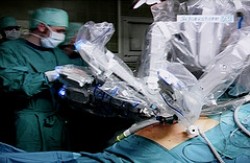In the NYU Langone Medical Center in New York, the first surgery of the month was performed with the help of a new near Infrared fluorescence imaging guided system included in the da Vinci Si Surgical System, which is the world’s most sophisticated robotic system.
This system gives an enhanced visual field, which permits more precise operations and minute assessments. This center is the first to use the new IR guidance system for selective clamping of arteries during the kidney sparing surgery for kidney cancer patients.
 Robotic Surgery Made More Precise With New Technology
Robotic Surgery Made More Precise With New Technology
The system included a unique camera and endoscope, which would capture images of the blood vessels and tissues by injecting a special fluorescence dye, which gets activated by near IR light. According to Michael Stifelman, NYU’s Director of Robotic Surgery Center and Associate Professor in the Department of Urology, the combination of the new three-dimensional HD camera and fluorescence imaging would give the surgeons a lucid and clear picture of the vascular anatomy of the patient and would change the way the surgery would be performed. Complex kidney surgeries could be performed in a better way utilizing a minimal invasive method. The precise imaging helps to temporarily stop blood flow to the specific part of the kidney, which needs dissection. The rest of the kidney would continue to be perfused, which averts damage to healthy tissue.
The three-dimensional HD camera is fixed on one of the four arms of the robot, which could switch from displaying the standard images of the surgical field to displaying the images of the blood vessels and tissue lighted up by the special dye. The miniature surgical instruments along with the extremely functional mechanics help in replicating every single movement of their hands. Both simple and complex procedures are possible by the robotic arms making the surgeries less traumatic for the patients, leading to faster recovery times and minimal scarring.